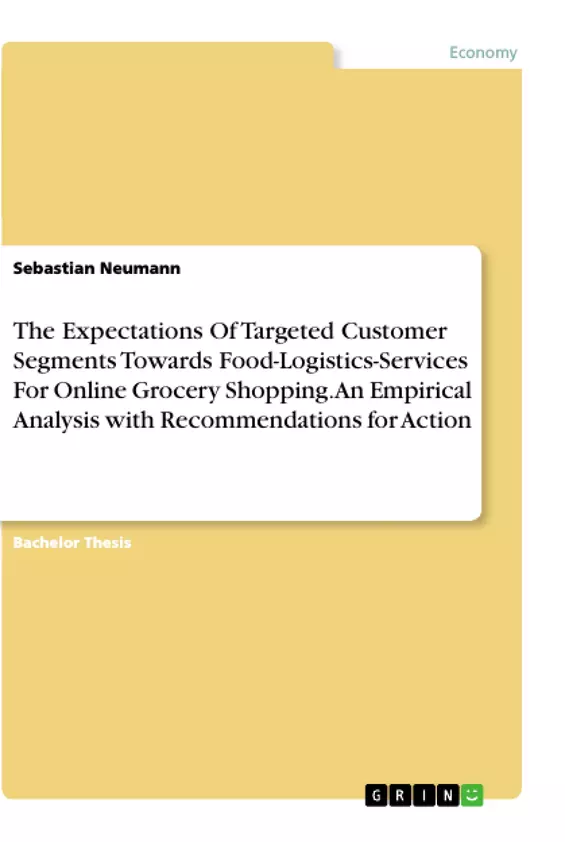This paper is about the expectations of targeted customer segments towards food-logistics-services for online grocery shopping. In recent years, the food retail sector in Germany entered the market with a new business model, which can be called "online-grocery-shopping". Unlike in other European countries, this business model is still at its beginning and encounters some challenges to develop and scoop its potential entirely. The research status mostly seems to consider just the trader, but little to no emphasis is on the transport service provider.
Especially the processes of them must ensure that sensitive groceries are handled and delivered with maximum care until the goods reach the final customer. Also, the German population is a sophisticated customer base, due to their high expectations regarding quality and service. Furthermore, the younger people are represented by high internet affinity, and they count as one of the present and future purchasing powers. This thesis utilizes a questionnaire to study 18-35-year old people regarding their expectations towards the transportation of groceries to contribute to the development of this business model. An assessment by the participants helps to identify the essential expectations.
Since Germans are tough customers, an ordinal logistic regression contributes to examine the identified expectations further. This reveals which properties of the customer, whether these are of demographic or fundamental nature, are affecting the expectations. Further, cross-pair comparisons of these properties are executed to crosscheck, how exactly is a property affecting an expectation. After this, based on the results, recommendations for action are stated as specific as possible to help the transport service provider compensate the identified expectations.
Inhaltsverzeichnis (Table of Contents)
- INTRODUCTION
- Description of the Initial Situation and Study Overview
- Research Questions and Methodology
- Objective and Structure of this Thesis
- DEFINITION AND CLASSIFICATION OF BASIC TERMINOLOGY
- Transportation
- Transport Vehicles
- Transport Gadgets
- Food Retail Trade
- Definition
- Distribution-Types and Business Models within the Food Retail Trade
- Electronic Business
- E-Business Relationships
- Electronic Commerce
- Online-Food-Retailing
- Definition
- Business Models
- German Online-Food-Retailing
- Transportation
- RESEARCH DESIGN OF THE APPLIED METHODOLOGY
- Research Questions and Hypotheses
- Data Acquisition
- First Question Pool - Core Fundamentals
- Second Question Pool - Demographic Properties
- Third Question Pool - Evaluation of Aspects
- Selection of Sample
- Methodology of Data Analysis
- Development of Data
- Development of Preliminary Expectation
- Methodology of Examination
- Requirements of Ordinal Logistic Regression
- Cross-pair Comparisons
- Development of Recommendations
- DATA ANALYSIS
- Quota-Scheme Sample
- Gender and Age Groups
- Household Properties
- City and Community types
- Core Fundamentals
- Awareness
- Selection of Expectation - Confidence Intervals
- Delivery
- Marketing
- Service
- Price
- Identified Expectations, affecting Properties and Assumption Testing
- Delivery
- Marketing
- Service
- Price
- Cross-Pair Comparisons of Properties
- Delivery
- Marketing
- Service
- Price
- Quota-Scheme Sample
- RECOMMENDATIONS TO COMPENSATE THE EXPECTATIONS
- Delivery
- Marketing
- Service
- Price
Zielsetzung und Themenschwerpunkte (Objectives and Key Themes)
This thesis analyzes the expectations of young adults (aged 18-35) towards the transportation of groceries in the context of online grocery shopping in Germany. The research aims to contribute to the development of this burgeoning business model by identifying key expectations and their influencing factors.
- Customer expectations regarding online grocery delivery services.
- The impact of demographic and fundamental customer properties on these expectations.
- Developing actionable recommendations for transport service providers to meet identified customer expectations.
- The role of online grocery shopping in the German food retail sector.
- The importance of understanding customer expectations for the success of online grocery delivery services.
Zusammenfassung der Kapitel (Chapter Summaries)
- Introduction: The initial chapter provides an overview of the study, outlining its objective, research questions, and methodology. It describes the current state of online grocery shopping in Germany and highlights its potential and challenges.
- Definition and Classification of Basic Terminology: This chapter defines key concepts related to transportation, food retail trade, electronic business, and online food retailing. It provides a detailed explanation of relevant terms and business models.
- Research Design of the Applied Methodology: This chapter delves into the research design, outlining the methodology for data acquisition, analysis, and examination. It specifies the questionnaire used for collecting data, the sample selection process, and the statistical methods employed.
- Data Analysis: This chapter presents the findings from the data analysis, examining the demographics of the participants, their expectations regarding online grocery delivery services, and the influence of various factors on these expectations.
- Recommendations to Compensate the Expectations: This chapter provides specific recommendations for transport service providers based on the identified expectations. It outlines practical strategies for addressing customer needs and improving the overall online grocery shopping experience.
Schlüsselwörter (Keywords)
The study revolves around the concepts of transport service providers, German food retail, online-grocery-shopping, e-commerce, and ordinal logistic regression. It investigates the expectations of target customer segments, explores the impact of demographic and fundamental customer properties on these expectations, and provides recommendations for action based on empirical analysis.
- Quote paper
- Sebastian Neumann (Author), 2018, The Expectations Of Targeted Customer Segments Towards Food-Logistics-Services For Online Grocery Shopping. An Empirical Analysis with Recommendations for Action, Munich, GRIN Verlag, https://www.grin.com/document/918404



